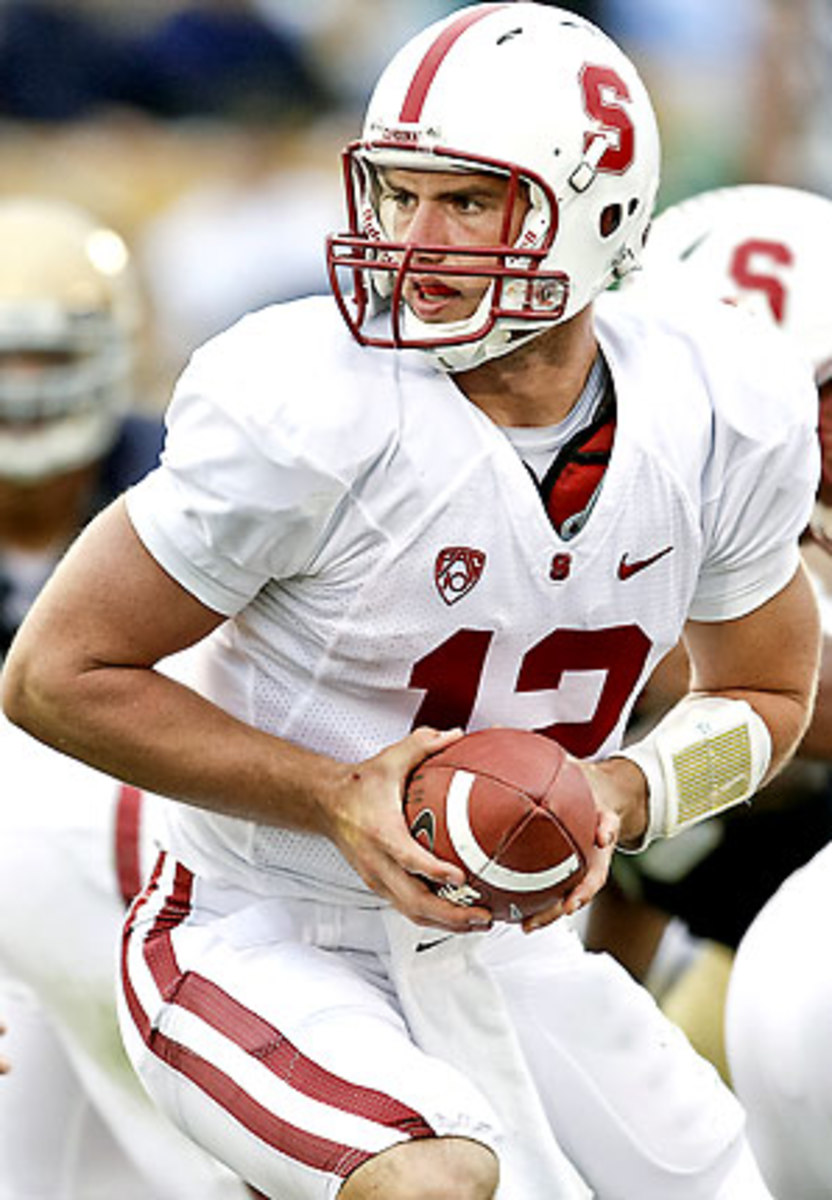Multifaceted offenses take center stage in clash of Pac-10 titans
Memo to Stanford offensive tackle James McGillicuddy: Do Nick Aliotti a favor and introduce yourself to him during warmups tomorrow. Aliotti, Oregon's upbeat, high-energy defensive coordinator, made a mental note to himself when McGillicuddy's name came up during a recent discussion of Stanford's offense.
"He's worn a different number every game," Aliotti said. "He's been 80, he's been 70-something, last I saw him he was 41. I've gotta figure out his number before the game."
A sixth-year, 6-foot-3, 307-pound senior who is close to completing work on his masters in communications, McGillicuddy gives us a glimpse into the difficulty of slowing the Stanford offense. "He's a hybrid," explains Aliotti. "They'll line him up at tight end, or fullback. He even lines up outside as a wide receiver, then comes back in and tries to hammer you."
With Cal, UCLA and Washington already sitting on two losses, and with USC marking time in NCAA purgatory, Saturday's game between No. 9 Stanford and No. 4 Oregon has turned into a clash of West Coast titans, and possibly the Pac-10's game of the year.
The Oregon offense is a video game, a series of nightmare scenarios for any defensive coordinator. The Ducks beat their first three opponents by a combined score of 189-13. They lead the nation in scoring offense (57 points per game), and may just be warming up. With Kenjon Barner looking fleet and healthy in practice this week (he had just a single touch in Oregon's 42-31 win over Arizona State), Oregon fans may finally see the sophomore on the field for long stretches alongside LaMichael James. Those two electrifying playmakers may line up in two-back sets, or Barner could line up as the "taser" -- head coach Chip Kelly's combination running-back receiver. Thus far this season, first year quarterback Darron Thomas hasn't run many of Kelly's signature zone-read plays. That could change against the Cardinal.
But the Ducks won't hold a monopoly on multiple formations, misdirection and deception. Ask Aliotti, who'll get back to you, as soon as he figures out what number McGillicuddy's wearing.
Aliotti is constantly telling his defenders to read their keys, trust their eyes. So it's not surprising that he notices a visitor's eyes wandering to the grease board in the coach's meeting room.
"I'm old-fashioned," he says. "I chart every play by hand, then I put 'em up."
What are all those plays under the heading "11"?
"They'll go with 11 personnel -- that's one back, one tight end. But sometimes they'll line up in a two back set out of it, then trade and shift and motion.
"They'll go 12 personnel -- one back, two tight ends -- and line up in a three-back set. Then they give you Flop" -- unbalanced.
What are those columns over there on the right -- "23" and "32"?
"Then they give you three tight ends, two backs, then three backs, two tight ends. Then they give you six offensive linemen" -- now we're getting into McGillicuddy territory.
"It's, umm, it's a pain in the ass," admits Aliotti, "because you only have so many hours in a week to prepare your kids."
It's not easy coordinating the defense for a team whose offense scores as quickly as Oregon's. Nineteen of the Ducks' 24 touchdown drives this season have taken 1:49 or less. Eleven TD drives have last 56 seconds or less. To keep bodies fresh, Aliotti rotates guys in with much more frequency than most other defenses. "It's like hockey players coming over the railing," he says. Yes, the Ducks yielded 597 yards of offense to Arizona State, but they were also on the field for 100 snaps. (ASU's D was on the field for 68.) And they got those seven takeaways.
"We needed 'em," says Aliotti.
Saturday's game is intriguing on so many levels. It's a contrast of explosive, yet starkly different offenses. Led by Andrew Luck, whom Harbaugh describes as a future NFL "franchise" quarterback, Stanford is averaging 48 points per game. Where Kelly's system relies largely on deception and blinding speed, Harbaugh, the ex-Michigan quarterback who played for Bo Schembechler, has installed a power-based system that methodically mauls opponents. (You can take the boy out of the Big Ten...)
I'm most interested in seeing how the Ducks, who are lightning quick, relentless to the ball and opportunistic -- again, they forced seven turnovers against the Sun Devils last week (and needed every one) -- match up against a bulkier opponent intent on mashing and tenderizing them, then going over their heads with play-action passes.
"Is it possible they can line up and knock us off the ball?" says Aliotti. "That's always possible." In fact, it's exactly what happened last November. Coming off a couple huge wins, including one over USC, the Ducks came out flat against the Cardinal and got hit in the mouth. Stanford jumped to a 31-14 lead, then hung on for dear life, finally clinching a 51-42 win.
"It's possible, but I think our kids have enough pride, they will battle their tails off," says Aliotti.
The truth is, it's still early in the season. Two of Oregon's wins are over New Mexico and Portland State. "I'm not really sure how good we are, or how good they are," says Aliotti.
We're about to find out. First, however, Aliotti would like to find out McGillicuddy's jersey number.






